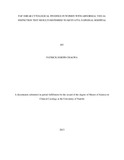| dc.contributor.author | Chagwa, Patrick Joseph | |
| dc.date.accessioned | 2013-10-25T12:38:29Z | |
| dc.date.available | 2013-10-25T12:38:29Z | |
| dc.date.issued | 2013 | |
| dc.identifier.citation | degree of Master of Science in Clinical Cytology at the University of Nairobi | en |
| dc.identifier.uri | http://erepository.uonbi.ac.ke:8080/xmlui/handle/11295/57913 | |
| dc.description.abstract | BACKGROUND:
Cervical cancer is the leading cause of cancer mortality in women in the developing countries.
The challenge of cost in establishing cytology and/or Human Papilloma Virus (HPV) mass screening for cervical cancer in these resource limited settings prompted adoption of visual inspection techniques as alternative screening methods for cervical cancer. Kenyatta National Hospital (KNH) receives women with abnormal visual inspection test results from peripheral health care centers for further management.
STUDY OBJECTIVES:
Broad objective: To describe the Pap smear cytological findings in women with abnormal visual inspection test results referred to Kenyatta National Hospital.
Specific Objectives: The study objectives were to describe the pattern of cervical epithelial cell abnormalities, to determine infective and other non-neoplastic findings in cervical smears in women with abnormal visual inspection with acetic acid/ visual inspection with Lugol’s iodine (VIA/VILI) referred to KNH and to compare VIA/VILI with Pap smear results.
STUDY DESIGN:
This was a cross-sectional descriptive study.
METHODOLOGY:
Study area: the study was conducted at KNH in the Family planning clinic, cytology and
histology laboratory facilities.
Study population: Consenting women 18 years and above with abnormal VIA/VILI referred to KNH for further management. A total of 232 women were recruited.
Specimen collection, processing and reporting: Pap smears were collected by qualified health care personnel, processed by the investigator using Papanicolaou staining procedure, reported by the investigator and signed out by a pathologist.
RESULTS:
All participants in this study (232) had positive result for visual inspection tests (VIA/VILI). Of these, 175(75.4%) had a report of negative for intraepithelial lesion or malignancy (NILM) while 57 (24.6%) had a report of atypical squamous cells of undetermined significance (ASCUS) or worse on Pap smear. The commonest lesion reported was high grade squamous intraepithelial lesion (HSIL), 20/57(35.1%) followed by squamous cell carcinoma, 18/57(31.2%). Of the 57(24.6%) abnormal cases 39 representing 16.8% of the total number of study participants were referred for colposcopy and biopsy while participants with reports of ASCUS and low grade
squamous intraepithelial lesion (LSIL) were recommended for follow up after 6 and 12 months respectively. Out of the 232 participants, 11(4.7%) were reported as having infections. Of the 232 study participants, 33(14.2%) were more than 50 years of age. Kenya Government policy does not recommend cervical cancer screening using visual inspection tests in women who are more than 50 years of age.
CONCLUSIONS:
Majority of women in this study had normal Pap smear cytological findings and only few had significant lesions and were therefore triaged for definitive diagnosis and/or treatment.
RECOMMENDATIONS:
· Pap smear should continue being used to triage women with positive visual inspection
test results.
· Increase awareness to service providers and the general public about the Government
Policy on the use of visual inspection tests in women more than 50 years of age since
14.2% were inappropriately screened by the visual inspection test | en |
| dc.language.iso | en | en |
| dc.publisher | University of Nairobi | en |
| dc.title | Pap Smear Cytological Findings In Women With Abnormal Visual Inspection Test Results Referred To Kenyatta National Hospital | en |
| dc.type | Thesis | en |
| dc.description.department | a
Department of Psychiatry, University of Nairobi, ; bDepartment of Mental Health, School of Medicine,
Moi University, Eldoret, Kenya | |
| local.publisher | College of Health Sciences | en |

